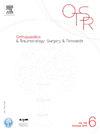反向全肩关节成形术中的肌腱转移:生物力学研究的系统性回顾和描述性综合。
IF 2.3
3区 医学
Q2 ORTHOPEDICS
引用次数: 0
摘要
背景:在反向全肩关节置换术(RTSA)中,肌腱转移和理想插入部位对改善轴向旋转的作用存在争议。我们系统地回顾了现有的生物力学证据,以阐明在反向全肩关节置换术(RTSA)中恢复外旋和内旋的理想肌腱转移和插入部位,以及假体侧移的影响:我们查询了 PubMed/MEDLINE、Embase、Web of Science 和 Cochrane 数据库,以确定有关在同时进行 RTSA 的情况下应用肌腱转移来增强肩关节外旋或内旋活动范围的生物力学研究。我们对收录的六篇文章进行了描述性综合,以阐明文献中的趋势:生物力学文献表明,增加肱骨侧外侧化可优化ER和IR的肌腱转移。ER的最佳背阔肌(LD)转移部位是大结节后方(邻近小圆肌插入点);然而,与后桡侧插入点相比,LD转移到该部位会导致更大的肌腱偏移。在一项平均随访近 7 年的小型系列研究中,LD 转移显示出了长效性,与对侧原生肩关节相比,所有 10 个肩关节的 ER 力量均大于 50%,最近一次随访时霍恩布洛尔氏试验结果为阴性;但与原生对侧相比,转移的 LD 肌电图活动有所减弱。一项研究发现,在肱骨外侧RTSA的情况下,胸大肌转移最有可能恢复IR:结论:为恢复ER,大结节后方的LD转移提供了最佳的生物力学和功能寿命。胸大肌具有恢复内收的最大潜力。未来需要应用本文总结的生物力学原理进行临床研究,以证实肌腱转移在现代侧向RTSA中的作用:证据等级:IV;系统综述。本文章由计算机程序翻译,如有差异,请以英文原文为准。
Tendon transfers in reverse total shoulder arthroplasty: A systematic review and descriptive synthesis of biomechanical studies
Background
The role of tendon transfer and ideal insertion sites to improve axial rotation in reverse total shoulder arthroplasty (RTSA) is debated. We systematically reviewed the available biomechanical evidence to elucidate the ideal tendon transfer and insertion sites for restoration of external and internal rotation in the setting of RTSA and the influence of implant lateralization.
Patients and methods
We queried the PubMed/MEDLINE, Embase, Web of Science, and Cochrane databases to identify biomechanical studies examining the application of tendon transfer to augment shoulder external or internal rotation range of motion in the setting of concomitant RTSA. A descriptive synthesis of six included articles was conducted to elucidate trends in the literature.
Results
Biomechanics literature demonstrates that increasing humeral-sided lateralization optimized tendon transfers performed for both ER and IR. The optimal latissimus dorsi (LD) transfer site for ER is posterior to the greater tuberosity (adjacent to the teres minor insertion); however, LD transfer to this site results in greater tendon excursion compared to posterodistal insertion site. In a small series with nearly 7-year mean follow-up, the LD transfer demonstrated longevity with all 10 shoulders having > 50% ER strength compared to the contralateral native shoulder and a negative Hornblower's at latest follow-up; however, reduced electromyography activity of the transferred LD compared to the native contralateral side was noted. One study found that transfer of the pectoralis major has the greatest potential to restore IR in the setting of lateralized humerus RTSA.
Conclusion
To restore ER, LD transfer posterior on the greater tuberosity provides optimal biomechanics with functional longevity. The pectoralis major has the greatest potential to restore IR. Future clinical investigation applying the biomechanical principles summarized herein is needed to substantiate the role of tendon transfer in the modern era of lateralized RTSA.
Level of evidence
IV; systematic review.
求助全文
通过发布文献求助,成功后即可免费获取论文全文。
去求助
来源期刊
CiteScore
5.10
自引率
26.10%
发文量
329
审稿时长
12.5 weeks
期刊介绍:
Orthopaedics & Traumatology: Surgery & Research (OTSR) publishes original scientific work in English related to all domains of orthopaedics. Original articles, Reviews, Technical notes and Concise follow-up of a former OTSR study are published in English in electronic form only and indexed in the main international databases.

 求助内容:
求助内容: 应助结果提醒方式:
应助结果提醒方式:


